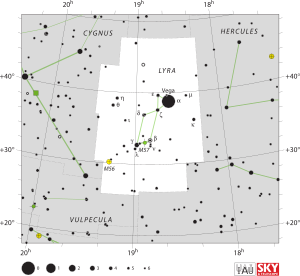
| |
| Observation data Epoch J2000.0 Equinox J2000.0 | |
|---|---|
| Constellation | Cygnus |
| Right ascension | 19 11 32.53446 |
| Declination | +45° 31′ 22.6081″ |
| Apparent magnitude (V) | 10.05 |
| Characteristics | |
| Evolutionary stage | Red-giant branch star |
| Spectral type | G8III |
| B−V color index | 0.90 |
| J−H color index | 0.474 |
| J−K color index | 0.549 |
| Astrometry | |
| Radial velocity (Rv) | 17.408899±0.007546 km/s |
| Proper motion (μ) | RA: 3.138 mas/yr Dec.: −15.988 mas/yr |
| Parallax (π) | 2.4141 ± 0.0098 mas |
| Distance | 1,351 ± 5 ly (414 ± 2 pc) |
| Details | |
| Mass | 1.24 M☉ |
| Radius | 5.636 R☉ |
| Luminosity | 18.759 L☉ |
| Surface gravity (log g) | 3.029 cgs |
| Temperature | 5069 K |
| Metallicity | −0.32±0.03 dex |
| Age | 4.61±0.23 Gyr |
| Other designations | |
| BD+45° 2850, Gaia DR3 2130219769257640576, HIP 94292, KIC 9145955, TIC 158626942, TYC 3542-2131-1, 2MASS J19113253+4531225 | |
| Database references | |
| SIMBAD | data |
HIP 94292, commonly referred to by its KIC designation KIC 9145955, is a red-giant branch star located in the northern constellation of Lyra.
Description
It has an apparent magnitude of 10.05, which makes it too faint to observe with the naked eye, but readily visible through a 35-mm aperture telescope. Gaia EDR3 parallax measurements place the star some 1,351 light-years (414 parsecs) distant, and it is receding with a heliocentric radial velocity of +17.4 km/s.
HIP 94292 is an evolved giant star with a spectral type of G8III. It is currently on the red-giant branch (RGB), undergoing the CNO cycle within a hydrogen shell surrounding an inert core made of helium. With a radius 5.6 times that of the Sun and an effective temperature just over 5,000 K (4,730 °C; 8,540 °F), it radiates 18.8 times the luminosity of the Sun from its photosphere. Due to its higher mass of 1.24 M☉, it is further evolved than the Sun despite a similar age of 4.61±0.23 billion years.
The helium core has been precisely measured to have a mass of 0.210±0.002 M☉ and a radius of 0.0307±0.0002 R☉. As expected of RGB stars, HIP 94292 exhibits solar-like oscillations.
See also
- KIC 9970396: a similar red giant in an eclipsing binary.
References
- ^ Brown, A. G. A.; et al. (Gaia collaboration) (2021). "Gaia Early Data Release 3: Summary of the contents and survey properties". Astronomy & Astrophysics. 649: A1. arXiv:2012.01533. Bibcode:2021A&A...649A...1G. doi:10.1051/0004-6361/202039657. S2CID 227254300. (Erratum: doi:10.1051/0004-6361/202039657e). Gaia EDR3 record for this source at VizieR.
- ^ Høg, E.; et al. (February 2000). "The Tycho-2 Catalogue of the 2.5 Million Brightest Stars". Astronomy and Astrophysics. 355 (1): L27 – L30. Bibcode:2000A&A...355L..27H.
- ^ Molenda-Zakowicz, J.; et al. (December 2008). "Spectroscopic Study of Candidates for Kepler Asteroseismic Targets - Solar-Like Stars". Acta Astronomica. 58: 419. arXiv:0907.0816.
- ^ "BD+45 2850". SIMBAD. Centre de données astronomiques de Strasbourg. Retrieved 24 October 2024.
- Jönsson, Henrik; et al. (17 August 2020). "APOGEE Data and Spectral Analysis from SDSS Data Release 16: Seven Years of Observations Including First Results from APOGEE-South". The Astronomical Journal. 160 (3). American Astronomical Society: 120. arXiv:2007.05537. doi:10.3847/1538-3881/aba592. ISSN 0004-6256.
- ^ Zhang, Xinyi; et al. (28 February 2018). "Frequency Identification and Asteroseismic Analysis of the Red Giant KIC 9145955: Fundamental Parameters and Helium Core Size". The Astrophysical Journal. 855 (1). American Astronomical Society: 16. arXiv:1802.01320. doi:10.3847/1538-4357/aaaabb. ISSN 0004-637X.
- Pérez Hernández, F.; García, R. A.; Corsaro, E.; Triana, S. A.; De Ridder, J. (21 June 2016). "Asteroseismology of 19 low-luminosity red giant stars from Kepler". Astronomy & Astrophysics. 591. EDP Sciences: A99. arXiv:1605.01567. doi:10.1051/0004-6361/201628311. ISSN 0004-6361.
- ^ Zhang, Xinyi; et al. (1 May 2022). "Determining the Age for the Red Giants KIC 9145955 and KIC 9970396 by Gravity-dominated Mixed Modes". The Astrophysical Journal. 931 (1). American Astronomical Society: 64. doi:10.3847/1538-4357/ac695b. ISSN 0004-637X.
- North, Gerald; et al. (2014). Observing Variable Stars, Novae and Supernovae. Cambridge University Press. p. 24. ISBN 978-1-107-63612-5.
| Constellation of Lyra | |||||||||||||||
|---|---|---|---|---|---|---|---|---|---|---|---|---|---|---|---|
| Stars |
| ||||||||||||||
| Exoplanets |
| ||||||||||||||
| Star clusters | |||||||||||||||
| Nebulae | |||||||||||||||
| Galaxies |
| ||||||||||||||